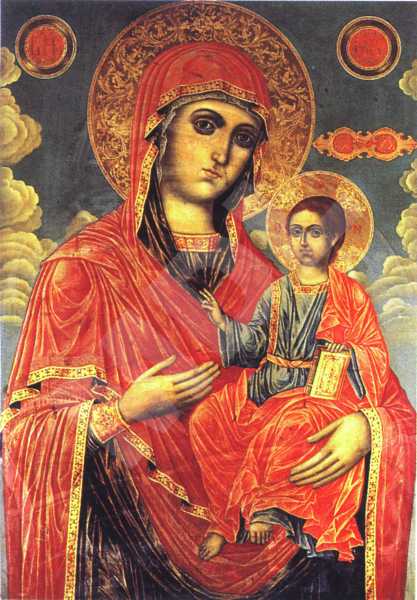The Virgin Hodegetria
Type:
Icon
Period:
1840 year
Dimiter T. Molerov, born in 1780 in Bansko, son of Toma Vishanov the Moler. One of the best-known painters, a representative of the Bansko school of art, a disciple of his father, influenced by the art of Athos. Author of the murals of the naos in the St Archangels' paraclete in the Rila monastery, the murals in the Church of the Assumption of the Virgin in the Pchelino dependance. In 1840 and 1841 together with his son Simeon Molerov he paints the murals and the sponsors' portraits in St. Nicholas' and St. John of Rila's paracletes in the principal church in the Rila monastery. Among D. Molerov's major achievements in iconography are the following icons: St. Nicholas (1816) from St. Archangel Michael's church in the village of Leshko, Christ All-triumphant with Angels and Cherubim (1833), The Nativity and a Crucifixion from St Elijah the Prophet's church in the village of Usenovo. He has also worked in Belgrade on an invitation by Prince Milosh Obrenovich of Serbia. He died in 1870 in Bansko.
Dimmensions (cm):
98
/ 80
/ 2.5
Location
Country: Bulgaria
Province: Blagoevgrad
Town: Bansko
Church: St. Trinity
Source
Country: Bulgaria
Province: Blagoevgrad
Town: Bansko
Church: St. Trinity
Object identification notes
The superb workmanship in the painting of the icon speaks for the hand of a very gifted iconographer.
Description
A traditional compositional treatment of the theme. The Holy Mother of God is portrayed in waist length against a pale-greenish background with white clouds. With her left arm she is embracing the Infant. Her right arm is bent and pointing at him. Christ is with a book in his left hand and is blessing with his right one. There are, in the icon's upper part, on both sides of the aureole of the Mother of God, two round medallions with her initials.
Iconographical technique: Combined
With velaturas and "probaster" on the garments. The varnish cover is applied in a thick and uneven layer. The gilding is with gold-leaf, with a rich Baroque engraving on the aureoles.
Base material: Wood
The icon's base is made of two white-pine panels, with two inserted wedge-shaped beams. The ground coat is of plaster, laid in a thin layer.
State, restoration traces and comments
No prior restoration has been detected.


